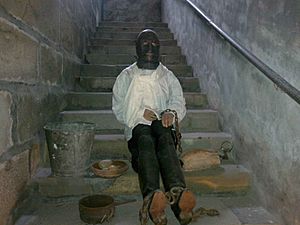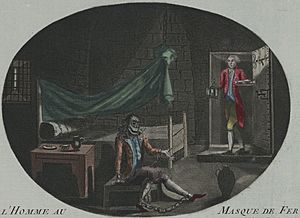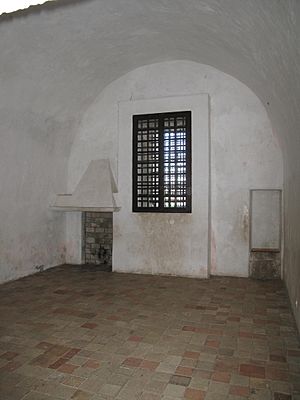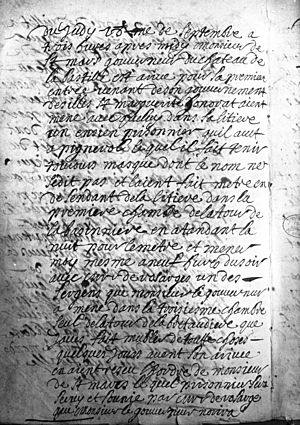The Man in the Iron Mask facts for kids

The Man in the Iron Mask was a mysterious prisoner of King Louis XIV of France. No one truly knows who he was. He was kept in prison from 1669 until he died in 1703. Most of the time, he had to wear a black cloth over his face, so no one could see who he was. The same guard, named Saint-Mars, always looked after him.
Most of what we know about this prisoner comes from letters written by his guard to his bosses. When he was first put in prison, he was called Eustache Dauger. He was buried in Paris, and his tombstone says his name was Marchiali. Other records also use names like Marchioly or Marchialy.
Contents
The Prisoner's Story
The first time this man was mentioned was in a letter written in 1711 by Elizabeth Charlotte, Madame Palatine. She said he always had to wear a mask, but she didn't know who he was. In 1698, a guard at the Bastille prison wrote that an old prisoner was being brought there, and he had to wear a mask. This guard was Bénigne Dauvergne de Saint-Mars, the same person who had guarded the masked man for years. Saint-Mars wrote many letters to François Michel Le Tellier de Louvois, who was the minister of war. Many letters from that time were lost because of strict rules about what could be written.
Early Imprisonment
On August 24, 1669, a man was imprisoned in Pinerolo, a town that was part of France back then. A few days before, on August 19, Minister Louvois said that this prisoner from Dunkerque was very important, but he hadn't been caught yet. The prisoner's name was given as Eustache Dauger.
In Pinerolo, he met other important prisoners, like Nicolas Fouquet and Antoine Nompar de Caumont. Dauger was allowed to talk to Fouquet. Sometimes, Dauger even acted as a servant for Fouquet when Fouquet's own servant was sick. In 1678, Fouquet asked for more freedom, and he got it. When Fouquet died in 1680, a secret hole was found between his cell and Caumont's cell. After this, both Fouquet's servant and Dauger were kept separate from Caumont. The Man in the Iron Mask and Fouquet's servant were then moved to Exilles, which was only about 26 kilometers away.
Moving Prisons
In 1682, the two prisoners were separated. Fouquet's servant died in 1687. Because of a possible war, the Man in the Iron Mask was moved again. This time, he went to the island of Sainte-Marguerite, near Cannes. At that time, only one other person was held prisoner there.
In September 1698, Dauger was moved to the Bastille prison in Paris. He stayed there until he died in 1703. Each time this unknown prisoner was moved, his guard, Saint-Mars, also moved and even got promoted to a higher position. The few other prisoners Saint-Mars guarded also moved with him.
Life in Prison
When the prisoner was in public or with strangers, he had to wear his mask. He was also not allowed to talk to anyone. When he was moved from one prison to another, people saw that no one could see his face, hear his voice, or speak to him.
Even though he was a prisoner, he seemed to live fairly comfortably. He received clean clothes twice a week and could ask for any book he wanted. He was allowed to play the lute, a musical instrument, and could see a doctor if he needed one. His guard, Saint-Mars, was given 12 livres a day for the prisoner's food and drink. The cell built for him on Sainte Marguerite Island cost a lot of money, about 5,000 livres. In Pinerolo, a special cell was built with three doors, and it was soundproof, meaning no one could hear anything from inside.
Saint-Mars was personally responsible for the prisoner's well-being. There are stories that officers had to take off their hats when they were near him and could only put them back on when told to. When he died, the prisoner was thought to be about 60 years old. When he was moved to Exilles in 1687, his hair was already gray.
The Mask He Wore
The Man in the Iron Mask probably did not wear his mask all the time. It's more likely he only wore it when he was being moved or when strangers might see him. If he had worn the mask constantly, it would have caused serious infections. Also, since he was a man, his facial hair would have needed to be cut sometimes. The need for him to wear a mask is only mentioned twice in historical records: once for his move to the Bastille and once for his move to the island near Cannes.
Voltaire's Story
The famous writer Voltaire was imprisoned in the Bastille in 1717. He later wrote that this prisoner was an older brother of King Louis XIV. In 1751, Voltaire published a book called "A Century of Louis XIV." In it, he wrote a detailed section about the Man in the Iron Mask. According to Voltaire, the man was imprisoned in 1661, after the death of Cardinal Mazarin. It's possible that much of what we know today about the "iron mask" part of the story was made up by Voltaire. He might have used this prisoner's story to show how bad an absolute ruler (a king with total power) could be.
The Real Eustache Dauger
When Minister Louvois first announced the prisoner's arrival, he gave his name as "Eustache Dauger." Historians have found records of a real man named Eustache Dauger de Cavoye who lived at that time. He was born on August 30, 1637, and his father was a guard for Cardinal Richelieu.
Historians also found that this real Eustache might have been involved in something called the Affair of the Poisons. This "affair" happened from about 1675 to 1680. During this time, many important people were poisoned or accused of witchcraft. Eustache got into trouble because he took part in fancy parties that included strange rituals.
In the 1930s, it was discovered that the real Eustache Dauger died in the Prison Saint-Lazaire in Paris. In the 1600s, this prison was also a kind of hospital for people with mental health problems, run by monks. Many noble families used it to hide family members who caused trouble. Records show that the real Eustache Dauger de Cavoye was kept in Saint-Lazaire in Paris around the same time the "false" Dauger was in Pinerolo. According to Louis-Henri de Loménie de Brienne, who was also imprisoned in Saint-Lazaire, the real Eustache Dauger de Cavoye died in the late 1680s. Historians now believe this proves that the real Eustache Dauger was not the Man in the Iron Mask.
Who Was He? Theories About His Identity
There are many ideas about who this mysterious prisoner could have been. Here are some of the most common theories:
Brother of Louis XIV
Voltaire believed the prisoner was a twin brother of King Louis XIV. He thought this brother grew up in a different place than the king. Voltaire said he was imprisoned in 1661, a few months after Cardinal Mazarin died. Another writer, Marcel Pagnol, also supported this idea.
Illegitimate Child of the Queen
Another idea is that the prisoner was an illegitimate child of Queen Anne of Austria. This means he was born outside of marriage. Some thought the father might have been Cardinal Mazarin, or George Villiers, 1. Duke of Buckingham, or even one of the king's musketeers. This theory is less likely because such a child would not have had a right to the throne, so imprisoning him wouldn't have been necessary to protect the king's power.
Father of Louis XIV
One theory suggests the prisoner was actually the father of Louis XIV. This idea claims that Cardinal Richelieu had a relationship with Queen Anne. Both Louis XIV and his father, Louis XIII, would have been involved to stop Gaston de Bourbon, duc d’Orléans from becoming king.
Someone Who Knew a Secret About Louis' Origins
An autopsy (a medical examination after death) of Louis XIII suggested he might not have been able to have children. Anyone who knew this secret would know about the true origins of Louis XIV. This knowledge could be very dangerous to the king. This theory suggests the prisoner was the doctor who performed that autopsy.
Why These Theories Are Unlikely
Today, there is no strong theory that fully explains who this man really was. The last person who might have known the prisoner's true identity was probably Michel Chamillart, one of King Louis XIV's ministers. Chamillart died in 1723.
Royal Family Theories
The theories that say the prisoner was a relative of King Louis XIV don't fit with how things were back then. The birth of a royal child, or even a noble child, was a very public event. Hundreds of people were present when Louis XIV was born. So, the idea of a "secret birth" of a twin brother is very unlikely. The strict social rules also made it almost impossible for Queen Anne of Austria to have a secret child. Also, the prisoner sometimes acted as a servant. People of noble birth would never have been servants during Louis XIV's time.
Servant Theories
The theories that say the prisoner was a simple servant also have problems. Even though he was imprisoned, he lived a comfortable life. A simple servant who caused trouble would likely have been killed, and no one would have cared about his comfort. But King Louis XIV himself showed interest in the prisoner's well-being.
The Man in Literature and Movies
The story of the Man in the Iron Mask has inspired many books and movies. The most famous is probably the story by Alexandre Dumas called "The Vicomte de Bragelonne." This is the third part of his famous work, The Three Musketeers. Other stories include "The Twins" by Victor Hugo and "The Iron Mask" by Marcel Pagnol. Dumas also wrote about the different theories people had about the prisoner in his time.
The story has also been used for several movies.
See also
 In Spanish: El hombre de la máscara de hierro para niños
In Spanish: El hombre de la máscara de hierro para niños




